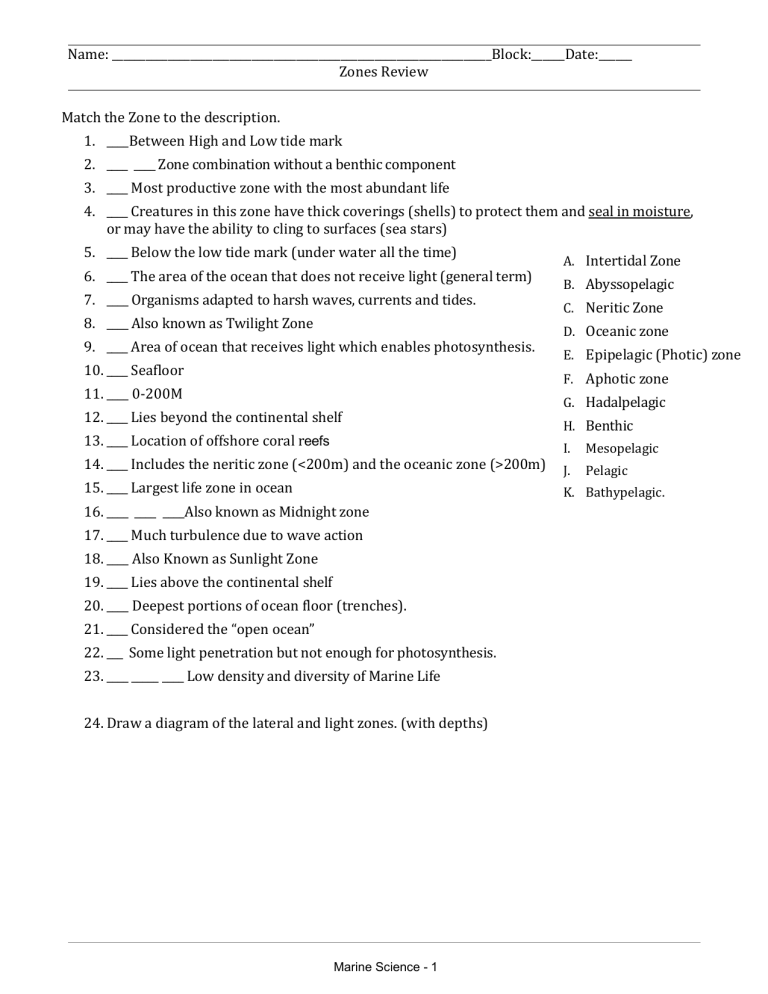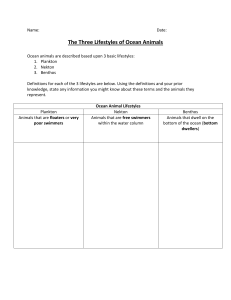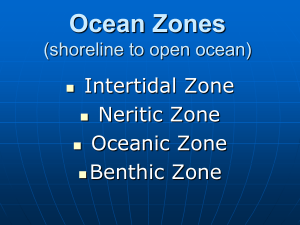
Name: ____________________________________________________________________Block:______Date:______ Zones Review Match the Zone to the description. 1. ____Between High and Low tide mark 2. ____ ____ Zone combination without a benthic component 3. ____ Most productive zone with the most abundant life 4. ____ Creatures in this zone have thick coverings (shells) to protect them and seal in moisture, or may have the ability to cling to surfaces (sea stars) 5. ____ Below the low tide mark (under water all the time) 6. ____ The area of the ocean that does not receive light (general term) 7. ____ Organisms adapted to harsh waves, currents and tides. 8. ____ Also known as Twilight Zone 9. ____ Area of ocean that receives light which enables photosynthesis. 10. ____ Seafloor A. Intertidal Zone B. Abyssopelagic C. Neritic Zone D. Oceanic zone E. Epipelagic (Photic) zone F. Aphotic zone 11. ____ 0-200M 12. ____ Lies beyond the continental shelf 13. ____ Location of offshore coral reefs 14. ____ Includes the neritic zone (<200m) and the oceanic zone (>200m) 15. ____ Largest life zone in ocean G. Hadalpelagic H. Benthic I. Mesopelagic J. Pelagic K. Bathypelagic. 16. ____ ____ ____Also known as Midnight zone 17. ____ Much turbulence due to wave action 18. ____ Also Known as Sunlight Zone 19. ____ Lies above the continental shelf 20. ____ Deepest portions of ocean floor (trenches). 21. ____ Considered the “open ocean” 22. ___ Some light penetration but not enough for photosynthesis. 23. ____ _____ ____ Low density and diversity of Marine Life 24. Draw a diagram of the lateral and light zones. (with depths) Marine Science - 1 Name: ____________________________________________________________________Block:______Date:______ Zones Review 25. ____ Free Swimmers 26. ____ Floaters or poor swimmers 27. ____ Bottom Dwellers 28. ____ Sponges 29. ____ Fish, Shrimp, Octopi 30. ____ Crabs, Sea Urchins L. Nekton M. Benthos N. Plankton 31. Label the lifestyle as Benthic, Plankton, Nekton 32. Compare and Contrast Zooplankton and Phytoplankton 33. Compare and Contrast Vagrant and Sessile Benthos Marine Science - 2





